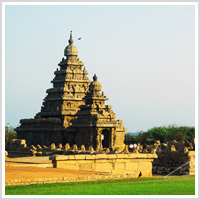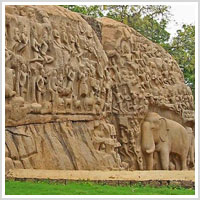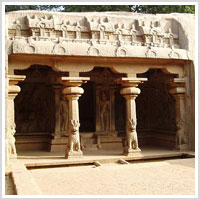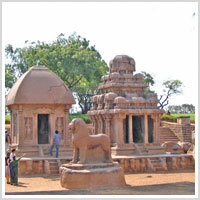
Chennai- Mahabalipuram Tour Package
 |
Shore Temple |
|---|---|
The Shore Temple is so named because it over looks the Bay of Bengal. It is a structural temple, built with blocks of granite, dating from the 8th century AD. It was built on a promontory sticking out into the Bay of Bengal at Mamallapuram. The village was a busy port during the 7th and 8th century reign of the Pallava dynasty during the reign of Narasimhavarman II.
|
 |
Arjuna Penance |
|---|---|
Measuring 96 feet (29 m) long by 43 feet (13 m) high, it is a giant open-air relief carved of the a monolithic rock. The monuments and sanctuaries were built by the Pallava kings in the 7th and 8th centuries. The legend depicted in the relief is the story of the descent of the sacred river Ganga to earth from the heavens led by Bhagiratha. The waters of Ganges are believed to possess supernatural powers. The descent of the Ganges and Arjuna's Penance are portrayed in stone at the Pallava heritage site.
|
 |
Varaha Cave Temple |
|---|---|
Varaha Cave Temple, an example of Indian rock-cut architecture dating from the late 7th century, is a rock-cut cave temple located at Mamallapuram, a tiny village south of Chennai in the state of Tamil Nadu, India. Part of the Group of Monuments at Mahabalipuram, the temple is a UNESCO World Heritage Site.
|
 |
Draupadi Arjuna Rathas |
|---|---|
Pancha Rathas an example of monolith Indian rock-cut architecture dating from the late 7th century located at Mamallapuram, a tiny village south of Madras in the state of Tamil Nadu, India. As one of the Group of Monuments at Mahabalipuram, it has been classified as a UNESCO World Heritage Site. |
 |
Five Rathas |
|---|---|
This group of sanctuaries, founded by the Pallava kings, was carved out of rock along the Coromandel coast in the 7th and 8th centuries. It is known especially for its rathas (temples in the form of chariots), mandapas (cave sanctuaries), giant open-air reliefs such as the famous 'Descent of the Ganges', and the temple of Rivage, with thousands of sculptures to the glory of Shiva.
|



» Mumbai
» Rameswaram
» Kodaikanal
» Kanyakumari
» Munnar
» Palani
» Tiruchendur
» Madurai
» Kumarakom
» Athirapally
» Thekkady
» Ooty
» Bangalore
» Trichy
» Thanjavur
» Cochin
» Mysore


Home | Tours from Madurai | Special Packages | South Special | Tamil Nadu | Kumarakom | Munnar | Hyderabad | Goa | Book Tour | Contact
South India Packages
Copyright © 2010 Madurai Tours and Travels. All Rights Reserved
Website Design and Developed by Sri Hema Infotech
![]()
